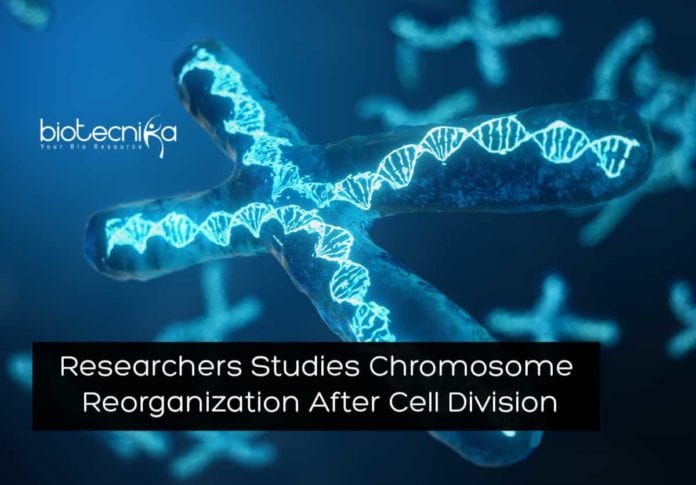Chromosome Reorganization After Cell Division
Have you ever wondered how a cell nucleus and its chromosomal material reorganizes itself after cell division?
Researchers have discovered vital mechanisms and structural details of this fundamental biological process. The new findings in chromosomal architecture & function may offer valuable insights into human disease.
Gerd A. Blobel, MD, Ph.D. at the Children’s Hospital of Philadelphia, said that as a cell divides into two daughter cells during mitosis, virtually all the genes are temporarily turned off. Also, the structures in chromatin fibers are disrupted. After mitosis, the daughter cells rebuild the complex chromatin structures within each cell nucleus.
In their research of Chromosome Reorganization After Cell Division, Blobel and the team of scientists describe the biological structures and dynamic forces that drive chromosome reorganization after mitosis. Blobel said that, despite the critical importance of the cell cycle, in which cells grow and divide, few scientists previously investigated the mechanisms of chromatin rebuilding.
The research team at Children’s Hospital of Philadelphia performed their experiments in blood-forming cells from a well-established mouse model. In the Chromosome Reorganization After Cell Division study, the researchers used sophisticated techniques called high throughput chromosome conformation capture (Hi-C) that detect and map
interactions across three-dimensional space between specific sites in chromosomal DNA. These maps also allowed scientists to measure such communications at different time points in the cell cycle.The study on Chromosome Reorganization After Cell Division detected the formation of structures in chromatin- the appearance and the expansion of transcriptionally active & silenced compartments; the creation of contact between regulatory regions of the genome including changes in the “architectural proteins” called CTCF and cohesin that help sculpt the genome.
Transcription- the process of conversion of information encoded in DNA into its equivalent in RNA stops temporarily during mitosis but reactivates thereafter in the daughter cells. Because gene mutations that disrupt typical genome architecture or transcription can play a crucial role in disease, a better understanding of chromatin architecture has potential clinical importance.
In The Study of Chromosome Reorganization After Cell Division, Blobel highlighted, offers valuable insights into fundamental aspects of a critical process in biology, i.e., the chromatin organization over space & time.
Editor’s Note: Chromosome Reorganization After Cell Division, Cell Division Study, Events After Cell Division





























